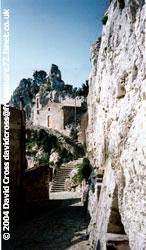 Sciacca is not really on the tourist trail
although it is extremely pleasant and some of the upper town is
really picturesque. There is no really cheap place to stay, though
the Paloma Bianca in Via Figuli was not really dear. The main
appeal of Sciacca for me is the fact that it is an ideal place for
an excellent bus trip to the hill village of Caltabellotta. Sicily
has so much to see [I missed the lovely west coast and most of the
interior, including a terrific Roman villa] that I suspect a lot of
people never make it to any of the smaller towns. Even though I
obviously saw them at the cost of some better known larger places,
Erice in particular, I feel that it is a pity not to sample some
and this is a beaut. From my knowledge of Sicilian hill villages I
would say that somehow they are less picturesque from a distance
but quite as good when inside them as those of the mainland. On the
ride to Caltabellotta it is going up high, rather than heading for
the village, which gives the pleasure and you need to be well up in
the village to see it at its best.
Sciacca is not really on the tourist trail
although it is extremely pleasant and some of the upper town is
really picturesque. There is no really cheap place to stay, though
the Paloma Bianca in Via Figuli was not really dear. The main
appeal of Sciacca for me is the fact that it is an ideal place for
an excellent bus trip to the hill village of Caltabellotta. Sicily
has so much to see [I missed the lovely west coast and most of the
interior, including a terrific Roman villa] that I suspect a lot of
people never make it to any of the smaller towns. Even though I
obviously saw them at the cost of some better known larger places,
Erice in particular, I feel that it is a pity not to sample some
and this is a beaut. From my knowledge of Sicilian hill villages I
would say that somehow they are less picturesque from a distance
but quite as good when inside them as those of the mainland. On the
ride to Caltabellotta it is going up high, rather than heading for
the village, which gives the pleasure and you need to be well up in
the village to see it at its best.
Having said that, once you go up from the bus terminus to the very top, you will certainly want to find ways to other parts of the crest. In one place you can go through a tunnel to see the magnificent view from the other side – if you are fully fit you could actually get this from the castle. The wind that hit me from the other side as I came out made it feel about fifteen degrees lower temperature. No doubt this is a considerable exaggeration but it was a great feeling in the reverse direction! Here there are two fine churches just below vast rock outcrops, one Norman and one Gothic. I use ‘Norman’, rather than ‘Romanesque,’ as a descriptor because the Normans did actually get to and settle on Sicily, unlikely as that may sound. I really go for rooftop views as well and the town below looks far more stunning to me from up here than from below.
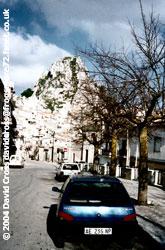 This was only my fifth night out of eleven but already lack of time
was forcing me to adjust my plans. I had meant to go right around
the island anti-clockwise and hopefully to do a trip into the Villa
Imperiale inland. I now realised this was far too much to take on
and I abandoned any notion of reaching the west coast or Segesta, a
spectacular site to the west of the island’s capital, Palermo. This
meant cutting from the south coast to the north at Palermo itself.
I decided on one further southern escapade first – a trip to the
ancient Greek settlement of Selinunte It was necessary to change at
Castelvetrano from the bus bound for Trápani to the local minibus
to Selinunte and the modern village of Marinellla which is little
more than the accommodation for those going to see Selinunte. It
turned out that the wait in this rather ordinary place
[Castelvetrano] was going to be over an hour and a half, and then
when the bus was quarter of an hour late.
This was only my fifth night out of eleven but already lack of time
was forcing me to adjust my plans. I had meant to go right around
the island anti-clockwise and hopefully to do a trip into the Villa
Imperiale inland. I now realised this was far too much to take on
and I abandoned any notion of reaching the west coast or Segesta, a
spectacular site to the west of the island’s capital, Palermo. This
meant cutting from the south coast to the north at Palermo itself.
I decided on one further southern escapade first – a trip to the
ancient Greek settlement of Selinunte It was necessary to change at
Castelvetrano from the bus bound for Trápani to the local minibus
to Selinunte and the modern village of Marinellla which is little
more than the accommodation for those going to see Selinunte. It
turned out that the wait in this rather ordinary place
[Castelvetrano] was going to be over an hour and a half, and then
when the bus was quarter of an hour late.
This afternoon was well up to the standards of the very best parts of my trip. Not only was the sun shining warmly from a blue sky but the spring flowers were blossoming in profusion all over the site and beyond. The site itself is terrific – as good a set of Greek remains as that at Agrigento to my mind and I felt that to have missed it would have been unpardonable. There are three areas of particular importance: the eastern temples, the Acropolis area and, some distance away, the Necropolis. I concentrated on the first two. This in itself covered a considerable area and involved several kilometres of walking but I am sure the number of people I saw was not as many as eighteen.
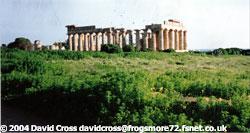 The eastern temples were mainly erected in the sixth century BC and
one of them, Temple E as it rather prosaically named, was
reconstructed in the 1950s. Apparently this was and is
controversial but I feel no qualms about it as long as some are
left as they are found. Whatever, it is a magnificent building and
I am sure a full size re-construction must be the best way of
illustrating to children what these temples were like. The
Acropolis area contains another five temples and most of the
ancient living area as well as the remains of the great walls.
These walls, however, are older than the rest of the remains,
having been built after the city had been destroyed once by
Carthage in order to defend the high ground from further
destructions.
The eastern temples were mainly erected in the sixth century BC and
one of them, Temple E as it rather prosaically named, was
reconstructed in the 1950s. Apparently this was and is
controversial but I feel no qualms about it as long as some are
left as they are found. Whatever, it is a magnificent building and
I am sure a full size re-construction must be the best way of
illustrating to children what these temples were like. The
Acropolis area contains another five temples and most of the
ancient living area as well as the remains of the great walls.
These walls, however, are older than the rest of the remains,
having been built after the city had been destroyed once by
Carthage in order to defend the high ground from further
destructions.
David was a keen walker, particularly on mountains before he developed serious heart problems in 1995. He has now adapted his holidays to what he is able to do and we are presenting his account of 12 days in Sicily over this and the coming months. Next two episodes: Palermo.

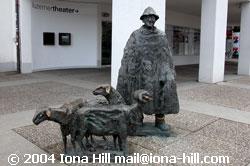 The name of St Moritz
has an interesting story attached to it: the story told to me was
that Maurice (later turned into Moritz) was a Christian and came
from Egypt. He served in the Roman army under Julius Caesar
and led a Theban legion for the Roman empire and fought in the
Alps. He refused to obey the order of the Emperor Maximian
and sacrifice some Christians to the Roman gods because he was
himself a Christian. On hearing this, Maximian ordered
Maurice's regiment to be decimated – i.e. every tenth person
killed, and this went on until no-one was left. And so
commanding officer Maurice became a saint. Legend has it that
the rock used by Maurice to lay his head on so that he could be
beheaded is at St Moritz. Like England's St George,
St. Maurice is a patron of knights and soldiers. From the
12th century, due the similarity between his name and Maurus, he
was depicted as a Moor, so he became the black saint.
The name of St Moritz
has an interesting story attached to it: the story told to me was
that Maurice (later turned into Moritz) was a Christian and came
from Egypt. He served in the Roman army under Julius Caesar
and led a Theban legion for the Roman empire and fought in the
Alps. He refused to obey the order of the Emperor Maximian
and sacrifice some Christians to the Roman gods because he was
himself a Christian. On hearing this, Maximian ordered
Maurice's regiment to be decimated – i.e. every tenth person
killed, and this went on until no-one was left. And so
commanding officer Maurice became a saint. Legend has it that
the rock used by Maurice to lay his head on so that he could be
beheaded is at St Moritz. Like England's St George,
St. Maurice is a patron of knights and soldiers. From the
12th century, due the similarity between his name and Maurus, he
was depicted as a Moor, so he became the black saint.
 There are lots
of bridges across the River Reuss, it reminded me a little of
Ljubljana, especially with some of the dragon symbols, some of my
friends said Stockholm. One of the most famous is the Chapel
bridge built in the 14th century as a part of the city's
fortifications and named after St. Peter's Chapel, which is
located nearby. It has paintings on it including some info on the
city's patron saints, St. Leodegar and our friend St.
Maurice. There's also a very splendid 17th century
baroque Jesuit church. I really liked the water spikes that
act like a lock to regulate water levels like in a canal. and
you can see the remains of water mills.
There are lots
of bridges across the River Reuss, it reminded me a little of
Ljubljana, especially with some of the dragon symbols, some of my
friends said Stockholm. One of the most famous is the Chapel
bridge built in the 14th century as a part of the city's
fortifications and named after St. Peter's Chapel, which is
located nearby. It has paintings on it including some info on the
city's patron saints, St. Leodegar and our friend St.
Maurice. There's also a very splendid 17th century
baroque Jesuit church. I really liked the water spikes that
act like a lock to regulate water levels like in a canal. and
you can see the remains of water mills.
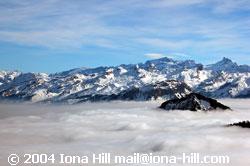 On my final day in
Lucerne, I went to the tourist information centre at the train
station and asked where I could go in the mountains. They
suggested a trip to Rigi Kulm, so, using my rail pass, instead of
paying 79 Swiss Francs, it cost me 29 Swiss Francs. It was a
great adventure! I took a boat across Lake Lucerne, and then
a funicular or cog wheel train up the mountain to the top of Rigi
Kulm, about 1,800m, so not too high, and then the cog wheel train
to the half way point and a cable car down to Weggis back down by
the lake, and the boat again back to Lucerne. It was a
wonderful half day trip, where we could see above the clouds, the
mountain tops poking through, then there was the lake and the green
of the alpine pastures leading up to the mountains. There are
a couple of other mountain type trips you can do like this whilst
based in Lucerne.
On my final day in
Lucerne, I went to the tourist information centre at the train
station and asked where I could go in the mountains. They
suggested a trip to Rigi Kulm, so, using my rail pass, instead of
paying 79 Swiss Francs, it cost me 29 Swiss Francs. It was a
great adventure! I took a boat across Lake Lucerne, and then
a funicular or cog wheel train up the mountain to the top of Rigi
Kulm, about 1,800m, so not too high, and then the cog wheel train
to the half way point and a cable car down to Weggis back down by
the lake, and the boat again back to Lucerne. It was a
wonderful half day trip, where we could see above the clouds, the
mountain tops poking through, then there was the lake and the green
of the alpine pastures leading up to the mountains. There are
a couple of other mountain type trips you can do like this whilst
based in Lucerne.